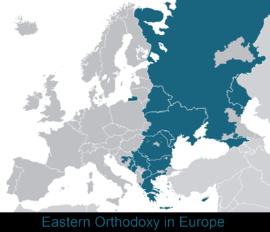Byzantine commonwealth
The term Byzantine commonwealth was coined by 20th-century historians to refer to the area where Byzantine general influence (Byzantine liturgical and cultural tradition) was spread during the Middle Ages by Byzantine statehood and missionaries. This area covers approximately the modern-day countries of Greece, Cyprus, R. Macedonia, Bulgaria, Serbia, Montenegro, Romania, Moldova, Ukraine, Belarus, southwestern Russia, and Georgia (known as the region of Eastern Orthodoxy in Europe).
The most important treatment of the concept is a study by Dimitri Obolensky, The Byzantine Commonwealth.[1] In his book Six Byzantine Portraits he examined life and works of six persons mentioned in The Byzantine Commonwealth.[2]
See also
References
Sources
- Obolensky, Dimitri (1974) [1971]. The Byzantine Commonwealth: Eastern Europe, 500-1453. London: Cardinal.
Further reading
- Billinis, Alexander. The Eagle Has Two Faces: Journeys Through Byzantine Europe. AuthorHouse Publishing, 2011. ISBN 9781456778705.
- Miliana Kaimakamova; Maciej Salamon (2007). Byzantium, new peoples, new powers: the Byzantino-Slav contact zone, from the ninth to the fifteenth century. Towarzystwo Wydawnicze "Historia Iagellonica". ISBN 978-83-88737-83-1.
- Meyendorff, John (1983), The Byzantine Legacy in the Orthodox Church. St Vladimir's Seminary Press, ISBN 0-913836-90-7.
This article is issued from
Wikipedia.
The text is licensed under Creative Commons - Attribution - Sharealike.
Additional terms may apply for the media files.
